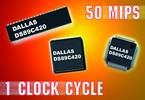

Dallas Semiconductor has announced a new DS89C420 ultra high-speed microcontroller. The new DS89C420 microcontroller is claimed to set a new speed record for 8051 type microcontrollers: one instruction per clock cycle at a maximum clock speed of 50 MHz. At 50 MIPS, the DS89C420 is 50 times faster than the original 8051 architecture. A unique feature is a 16 KB flash memory that can be programmed at different points in product manufacture or even within the target application.
According to the manufacturer, the DS89C420 hyper speed results from its latest redesign of the 8051 processor core. DS89C420 flash offers three programming modes. With in-system mode, an on-chip boot loader is used to open the flash memory to access through the serial port. With in-application mode, the on-chip memory management unit alternates memory blocks so that application software can execute in one block while the other is erased and programmed. Third, the DS89C420 supports standard Flash or EPROM programmers.
Frank Taylor, Dallas' Product Manager for microcontrollers, said, "Aside from design compatibility, all microcontrollers remain subject to one major performance gauge: the speed at which they execute instructions. The need for faster processing led to Dallas' first redesign of the 8051, which reduced the number of clock cycles per machine instruction from 12 to 4.
"This performance increase enables our 8051 design to more than meet the challenge from RISC (reduced instruction set computer) chips which reduce the program instruction set to achieve speed. It potentially takes several RISC instructions to achieve the same result as one 8051 instruction. The DS89C420 has both superior speed and the power of the full 8051 instruction set."
The 8 bit 8051 chip architecture remains popular in embedded systems design, which includes computer subsystems and peripherals, appliances, data and communications equipment, transportation, and industrial controls. The DS89C420 remains 100% pin and instruction-set compatible with existing 8051-based systems, but with speed that challenges RISC chips and with flexibility that extends flash programming.
The DS89C420 features two data pointers that can be used to move blocks of data both forwards and backwards. This unique capability to automatically increment or decrement the data pointer reduces the number of instruction steps and increases the speed of operation. Other resources include 13 interrupt sources with five priority levels instead of three, three 16-bit timer/counters and a watchdog timer. An internal clock divider circuit enables Power Management Mode, where the DS89C420 selects a processing speed based on software input and maintains all processes at lower power states without shutting down. Additionally, a clock multiplier is included to allow full-speed operation from lower speed, more readily available crystals.
| Tel: | +27 11 608 0070 |
| Email: | [email protected] |
| www: | www.cstelectronics.co.za |
| Articles: | More information and articles about CST Electronics |

© Technews Publishing (Pty) Ltd | All Rights Reserved